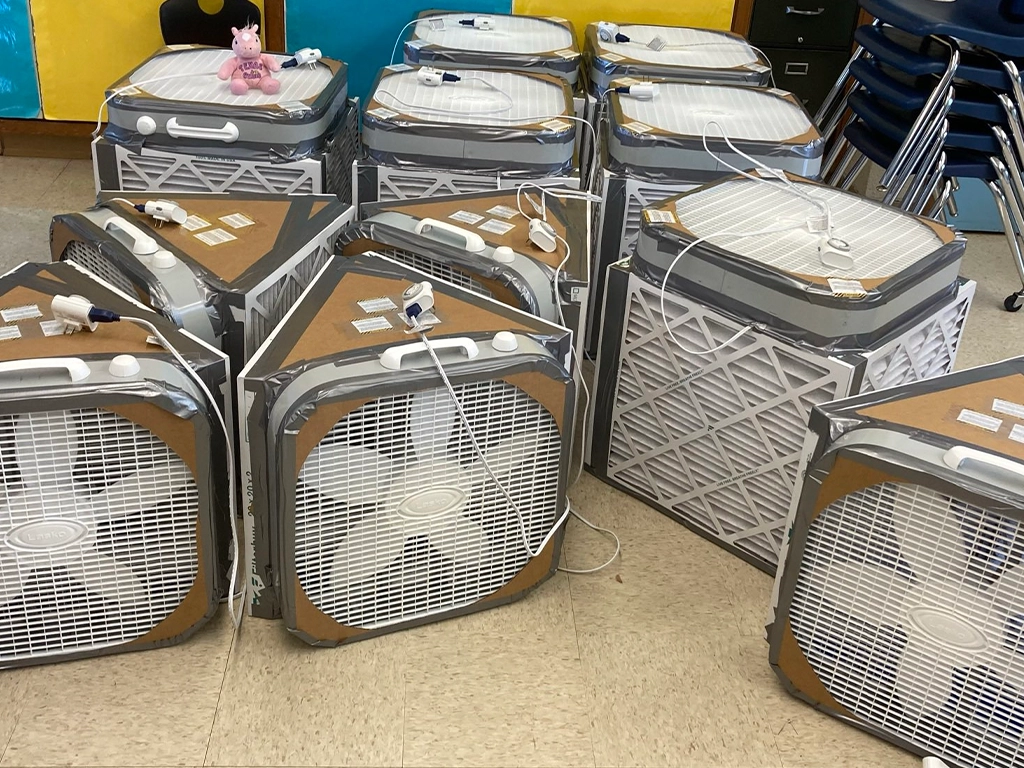Since its conception in 2020, the Corsi-Rosenthal Box has been embraced by schools, science-enthusiasts, and even the EPA as an economical air purification solution. As an organization that is dependent on people purchasing commercial air purifiers, you’d probably expect us to have a negative opinion on DIY purifiers. You’d be sorely mistaken. We think Corsi-Rosenthal Boxes are amazing...when certain circumstances align. To help your organization make the best decision, let’s discuss Corsi-Rosenthal Boxes and how they compare to traditional air purification technologies.
What Is a Corsi-Rosenthal Box?
In the early uncertainty of the COVID-19 pandemic, Dr. Richard Corsi — then Dean of Portland State University’s Maseeh College of Engineering and Computer Science — proposed a DIY design in Wired Magazine that would allow a standard household Box fan to filter the air without straining the fan’s motor. Texas air filter manufacturer Jim Rosenthal was inspired to improve on this design, building the first model of what would come to be known as the Corsi-Rosenthal Box.
Corsi and Rosenthal’s joint vision resulted in a 6-sided duct-taped cube; 4 (or sometimes 5) sides consisted of MERV 13 filters, while the 6th side was the box fan. When all components were arranged facing the correct direction, this contraption drew contaminated air in through the filters and sent clean air into the room. Later versions added a cardboard “shroud” — reducing backflow at the corners of the fan.
Clear Advantages of Corsi-Rosenthal Boxes
Why did these devices become so popular? Corsi-Rosenthal Boxes have 2 clear advantages over commercial purifiers:
1. Cost
Because they can be built out of items found at a local hardware store, Corsi-Rosenthal Boxes are extremely economical. At current rates from one HVAC supplier, the materials for a Corsi-Rosenthal Box would cost $61.95 before taxes and shipping. This makes the devices very appealing to some schools — whose budgets (and air quality) are often distinctly stratified according to the wealth of their surrounding communities.
2. Emergency Supply
Supply chains are built for normal circumstances, but crises can vastly increase demand. Both COVID-19 and the Canadian wildfires resulted in a shortage of some air purifier brands in retail stores. Thus, Corsi-Rosenthal Boxes seem to have a place during emergencies — as something is better than nothing when it comes to cleaning your air.
Tentative Advantages of Corsi-Rosenthal Boxes
In contrast to the above, some advantages of Corsi-Rosenthal Boxes have caveats attached.
1. CADR: How Effective Is a Corsi-Rosenthal Box?
To refresh your memory, CADR (clean air delivery rate) is a calculation of how much clean air a passive purifier can deliver. An informal study at the University of California at Davis estimated that the CADR of a Corsi-Rosenthal Box is 165-239 cubic feet per minute, making it “within the range of commercially available portable air cleaners designed for the residential market.”
However, there is a problem with precisely determining Corsi-Rosenthal’s effectiveness. Due to its DIY nature, there is no such thing as a standardized Corsi-Rosenthal Box. The brand and power of fans vary widely. The material and width of MERV 13 filters also vary. In other words, if you’ve tested one Corsi-Rosenthal Box, you’ve tested only that one Corsi-Rosenthal Box. Trusting claims about “Corsi-Rosenthal Boxes” as if they were sold in stores might be a good bet (especially for cash-strapped organizations in a crisis,) but it wouldn’t meet the rigorous criteria for scientific or legal verification. To give an example:
- A later formal study by UC Davis measured a much higher CADR of 573 to 902 ft3/min. Such extraordinary results might be connected to the fact that Corsi-Rosenthal Boxes have a large surface area. However, as these latter results appear to be much higher than other studies of Corsi-Rosenthal Boxes, we suggest that consumers take them with a grain of salt until they can be replicated.
Nevertheless, while the estimated effectiveness of Corsi-Rosenthal Boxes varies, we were unable to find any study where they were ineffective or less effective than a passive commercial purifier. Thus, we are not advocating against Corsi-Rosenthal Boxes, merely advocating for an understanding of what testing results connected to them mean.
2. Energy Use: How Efficient Is a Corsi-Rosenthal Box?
The UC Davis studies both found that Corsi-Rosenthal Boxes either match or exceed the energy efficiency of standard commercial passive purifiers. While this may be more efficient than a standard passive purifier, it is not more efficient than all commercial purifiers. Products with our technology tend to match or improve upon that power draw. For instance, the Beyond Guardian Air II with ActivePure Technology has a consumption of 23-80 watts, easily beating the raw power consumption of the Corsi-Rosenthal setup measured above.
3. Maintenance: How Often Do Filters Need to be Changed?
According to Jim Rosenthal, “The biggest mistake people make [with the Corsi-Rosenthal Box] is that they change the filters too soon.” He estimates that filters need to be changed every 6-10 months, putting them on par with True HEPA passive cleaners.
However, unless (like Rosenthal) you are able to weld together a reusable metal frame, do keep in mind that “changing the filters” on a Corsi-Rosenthal Box means rebuilding it from scratch.
Disadvantages of Corsi-Rosenthal Boxes
Corsi-Rosenthal Boxes have 3 clear disadvantages compared to purifiers with ActivePure® Technology.
1. Appearance
Corsi-Rosenthal Boxes aren’t compatible with the brand or messaging of many organizations. To put it bluntly, a Fortune 500 company shouldn’t put a duct-taped DIY Box in their lobby. The same applies to restaurants, small businesses, retail stores, etc. Organizations with any kind of brand or marketing strategy need to be consistent in the appearance they are presenting to customers and clients; thus, commercial purifiers, which can be either beautifully designed or hidden in the ceiling, are optimal for these organizations.
2. Size and Flexibility
As we explain on our company FAQ page:
“The very largest ActivePure machine (designed for[...]public spaces such as gymnasiums) takes up a little over 2 cubic feet of space. A Corsi-Rosenthal Box with a 20-inch Box fan would take up over twice that. Because of this [,] ActivePure® Technology can be installed in elevators, buses, cars, or right inside HVAC systems, while Corsi-Rosenthal Boxes cannot.”
Jim Rosenthal has designed a “mini-mini” Corsi-Rosenthal Box, but it takes up a seat in his car and presumably needs to be buckled in! Meanwhile, ActivePure’s portable car device plugs into the dashboard. At the end of the day for businesses, commercial purifiers would be a better option.
3. Passivity
A Corsi-Rosenthal Box, like all filtration-based technology, is passive. This means that it can’t clean any air that doesn’t pass through it. While such an arrangement might be tolerable for some contaminants, it is unacceptable for infectious aerosols. Corsi-Rosenthal Boxes do reduce the concentration of pathogens, which can reduce the infection rate even when contaminants aren’t completely reduced. However, we assert that such passive technologies are best supplemented by active technologies, which target pathogens out in the room itself. Devices with ActivePure® Technology have been proven to inactivate up to 99.9% of many common airborne pathogens in minutes.
The Importance of Layered Protections
Corsi-Rosenthal Boxes are excellent as a solution for emergency situations or budget-strapped organizations in rooms that don’t have restrictions on sound or branding. They also might work in private spaces where the risk of infectious aerosols is low. However, they are impractical (except as a temporary solution during a crisis) for almost any other scenario.
Neither ActivePure nor Corsi/Rosenthal should be upset by this conclusion. There is no such thing as a single air purification solution for all circumstances. To achieve desired indoor air quality, multiple solutions are often necessary. The ideal combination of solutions for your organization will factor in contaminants, costs, practicality, and organizational goals. In many situations, a Corsi-Rosenthal Box is on that list of ideal solutions; however, in many other situations, you're better off just buying an air purifier.
To hear from an organization that was satisfied in its investment in purifiers with ActivePure® Technology, watch the testimony below.



